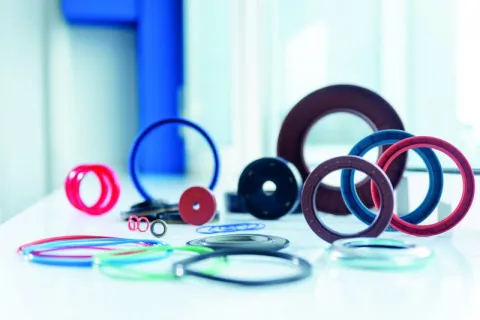ttv-outstanding performance for any requirements
07.05.2021the lord of the rings
 The classic O-ring is probably one of the most commonly processed technical products there is, and is used millions of times across countless applications.
The classic O-ring is probably one of the most commonly processed technical products there is, and is used millions of times across countless applications.
Invisible from the outside, ttv O-rings stand out thanks to their inner values. After all, O-rings from ttv are made in compliance with current standard DIN 3601-1 and meet the most stringent quality standards.
The O-rings are predominantly made from elastomer materials with different compositions which are often customer-specific. Static seals are used in stationary machine components, whereas dynamic seals are used in rotating components.
Compression and extension
When a sealing ring is installed, it should not be compressed by more than 4% in order to prevent distortion in the groove. The extension of the inner diameter should not exceed 5% when installed. Otherwise, there could be a disproportionate reduction in the cross-section. A 1% extension of the inner diameter brings about a reduction in cord thickness of approx. 0.5%. Compression Compression refers to any percentage of the cord thickness d2 by which the O-ring is compressed when installed. There is therefore a direct correlation between the compression and the groove depth. With the same compression percentage, the deformation forces increase as the cord thickness d2 increases. To compensate for this, the compression percentage is reduced as the crosssection diameter increases.
Materials The following table contains an overview of the various materials with regard to temperature differences and application area.
| Haupt- materialien |
Temperaturbereich von - bis |
Einsatzbereich | |
| Nitril NBR |
- 30 Grad | + 100 Grad (120 Grad kurzzeitig) |
Hydrauliköl, Schmierfett, Kohlenwasserstoff, Öl, Fette, Pflanzenöl, Wasser, Druckluft |
| HNBR | - 30 Grad | +130 Grad (150 Grad kurzzeitig) |
Ozon, UV, warmes Wasser, Schwefel, enthaltene Öle |
| Chloropren CR |
- 30 Grad | +100 Grad (120 Grad kurzzeitig) |
Luft, Ozon, Wasser bis 80 Grad, Pflanzenöl, Sauerstoff, Soda, Chlor, Fettalkohol, Kühlgas, Lebensmittelbereich CO² |
| Ethylen/ Propylen EPDM |
- 40 Grad | +110 Grad (130 Grad kurzzeitig) |
Lebensmittelbeständig (wenn peroxydvernetzt): Wasser, Getränke Benutzung mit entzündbaren Flüssigkeiten, Dampf, verschiedene Säuren, Soda, Glykol, Ozon, warnes Wasser |
| Silikon VMQ |
- 50 Grad | +200 Grad |
Tiefen und hohe Temperaturen, Luft, Sauerstoff, Intergas, schwache Säure und Basen, Ozon |
| Fluorkautschuk FKM |
- 20 Grad | + 200 Grad | Gute Ölbeständigkeit, hydraulische Flüssigkeiten, Lösungsmittel, entzündbare Öle und Chemikalien, Ozon |
| PTFE | - 150 Grad | + 260 Grad | Sehr gute chemische Beständigkeit, guter elektrischer Isolierstof, niedriger Reibungskoeffizient |